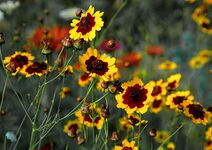Coreopsis tinctoria
| Coreopsis tinctoria | |
 | |
| Light: | |
| Moisture: | |
| Soil pH: | 5.6-8.4 |
| Height: | 2' |
| Width: | 1' |
| Blooms: | Early Summer-Early Fall |
| Native to: | |
| Shelter | |
| Edible Rating: | |
| Medicinal Rating: | |
| Tea: | Yes |
Coreopsis tinctoria (common names: coreopsis and golden tickseed)
Propagation: Seed - sow March in a cold frame. When they are large enough to handle, prick the seedlings out into individual pots and plant them out in the summer[1].
If you have sufficient seed then it can also be sown in situ outdoors.
Cultivation: Succeeds in ordinary garden soil[2]. Prefers a fertile well-drained moisture retentive medium soil[1][3]. Does well in sandy soils[4]. Requires a sunny position[1][3]. Established plants are drought resistant[2].
A good bee plant[3].
Range: Central and Eastern N. America - Minnesota to Texas.
Habitat: Moist low ground[5]. Roadsides and waste places[6].
Edibility: A tea can be made from the dried plant[7]. It was used as a coffee substitute[7].
Medicinal: A tea made from the roots is emetic and is also used in the treatment of diarrhoea[8][7].
An infusion of the whole plant without the root has been used by women desiring a female baby[7].
Usage: A yellow (red with an acid mordant) dye is obtained from the flowers and is used to dye cloth[9][6][7]. It is not very good when used on plant fibres[9]. The flowers can be dried for later use[9].
Pollinators: Bees
Soil: Can grow in light and medium soils.
Drainage: Prefers well drained soil.
In Leaf: Mid Spring-Late Fall
Seed Ripens: Early Summer-Mid Fall
Flower Type: Hermaphrodite
Links
References
- ↑ 1.0 1.1 1.2 Sanders, Thomas. Popular Hardy Perennials. Collingridge, 1926.
- ↑ 2.0 2.1 Chittendon, Fred. RHS Dictionary of Plants. Oxford University Press, 1951.
- ↑ 3.0 3.1 3.2 Huxley, Anthony. The New Royal Horticultural Society Dictionary of Gardening. MacMillan Press, 1992.
- ↑ Brickell, Christopher. The RHS Gardener's Encyclopedia of Plants and Flowers. Dorling Kindersley Publishers, 1990.
- ↑ Hitchcock, Leo. Vascular Plants of the Pacific Northwest. University of Washington Press, 1955.
- ↑ 6.0 6.1 Phillips, Roger. Herbs. Pan Books, 1990.
- ↑ 7.0 7.1 7.2 7.3 7.4 Moerman, Daniel. Native American Ethnobotany. Timber Press, 1998.
- ↑ Foster, Steven and Billy Tatum. Medicinal Plants of Eastern and Central North America. Houghton Mifflin, 1990.
- ↑ 9.0 9.1 9.2 Buchanan, Rita. A Weavers Garden.